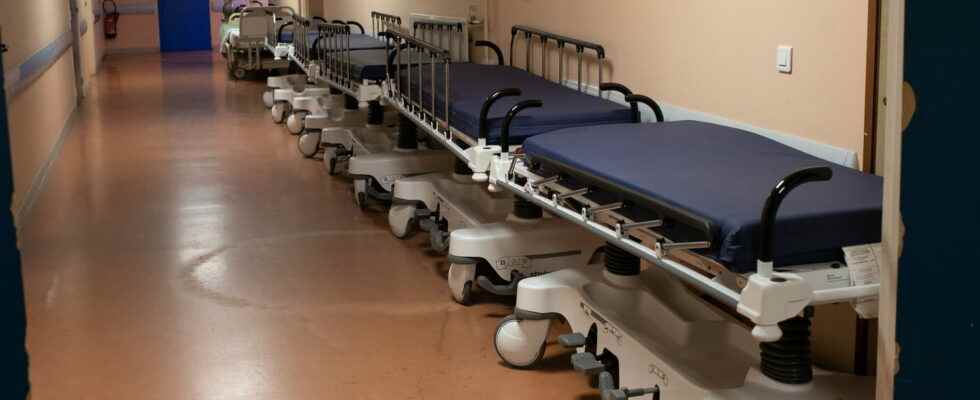Many figures are circulating about the abolition of hospital beds during Emmanuel Macron’s five-year term. To the point that it is difficult to navigate between an outgoing president and his supporters who defend their record and the camp of Marine Le Pen. We recap.
Caregivers have signed two forums, published in Release and in the JDD this week, declaring that they would block Marine Le Pen this Sunday, April 24, for the 2nd round of the presidential election, and would vote Emmanuel Macron. However, they evoke in their texts many dissatisfactions as for the management of the crisis of the public hospital by the current government. In particular, the number of “hospital beds”, a central criterion during the coronavirus crisis to assess the saturation of care services, has given rise to numerous debates.
According to a document from the Department of Research, Studies, Evaluation and Statistics (Drees) dated September latest (read here)”the number of critical care beds (resuscitation, intensive care and continuous monitoring), in high demand during the Covid-19 epidemic, increased by 3.6% between the end of 2019 and the end of 2020″. The Drees evokes “in particular, the intensive care unit capacity [qui] increased by 14.5%”. But this figure, which only concerns beds receiving patients requiring the most crucial care, does not reflect an overall trend in Emmanuel Macron’s five-year term. The general count of hospital beds is not so simple, but nevertheless reflects a clear decline.
Did the number of hospital beds drop during Macron’s five-year term?
75,000 hospital beds have been closed in sixteen years, a decrease of 16%reported Release last December in an article devoted to the subject and also based on data from DREES. “Between 2003 and 2019, the number of full hospitalization beds installed, all establishments, all disciplines and all sectors combined, increased from 468,000 to 393,000″ thus indicated the administration in the 2021 edition of its report on ” Health establishments”, which gives an overview of the situation (read here). To understand : this dynamic of bed closures is a reflection of policies prior to those decreed by Emmanuel Macron or its Minister of Health Olivier Véran. It dates back to the Chirac, Sarkozy and Hollande years. Olivier Véran also affirmed in July 2020, after months of health crisis, that the State had “finished with the dogma of closing beds. (…) We are taking the problem head-on but we pay for thirty years of carelessness.”
However, according to the latest figures available, measured by DREES in the Annual establishment statistics (EAS), the downward trend in the number of beds available in hospitals was confirmed during Emmanuel Macron’s mandate, despite the Covid-19 crisis and the Ségur de la santé. It should be noted that the “final” figures from the DREES are not published until two years after the year in question. The authorities also specify that it was very difficult to measure the number of beds over the years 2019 and 2020, due to the successive waves of coronavirus, which caused significant variations over the year.
Thus, in 2017, 4,900 hospital beds were closed, a decrease of 1.2% in the number of beds compared to the previous year. In 2018, 4,200 beds were still lost (a decrease of 1.1%). In 2019, 3,100 beds disappeared (a decrease of 0.8%) and finally, in 2020, the last year to have been measured, the closure of beds was estimated at 5,700, a decrease of 1.5% in the number of beds compared to the previous year, according to provisional official data. We will have to wait for the Drees report of July 2022 to know the exact figure for bed closures in 2020. By then, the figures could still change. Olivier Véran indeed affirmed in July 2020, during the Ségur de la Santé, that the State would finance an envelope of 50 million euros in order to open 4000 beds “on demand”.
How to explain the abolition of hospital beds?
On October 5, the Scientific Council, in charge of supporting the government during the Covid crisis, published a report in which it affirmed that 20% of the beds supposed to be open were in fact closed. This assessment was the result of a “flash” survey, carried out on a limited number of hospitals and consequently criticized by the Minister Delegate in charge of Autonomy Brigitte Bourguignon, as reported in this article by Public Senate. Despite some variations depending on the region, this phenomenon has nevertheless been confirmed by several university hospital directors, quoted by Mediapart : “CHU directors confirmed these figures in a joint press release: 14 to 18% of beds are closed in Île-de-France. In other regions, bed closures in the largest hospitals would vary between 1 and 12% .” Several factors may explain this situation:
Priority given to outpatient surgery. In January 2021, the Haute Autorité de Santé affirmed in one of its regular updates on indicators for improving the quality of care that “the public authorities support the development of care without overnight stay in order to achieve in 2022 a majority outpatient practice of 70%”. But in fact, only 58% of surgeries were performed in outpatient surgery in 2020 as in 2019, according to the French Association of Outpatient Surgery.
Also note: a closure of the beds at the time of the coronavirus crisis, with double rooms become single rooms, in order to prevent the spread of the epidemic.
Added to this, widely reported by Mediapart, a lack of nursing staff. Health professionals, exhausted, sometimes even manage to resign. Some beds would therefore be temporarily closed, due to the lack of nurses and doctors to welcome and care for all patients and to be able to “fill” these beds properly. The investigation site has devoted dozens of articles to this crisis in the French hospital. Overall, the hospital services denounce an “accounting logic”, which is not suitable for the management of the public hospital.
